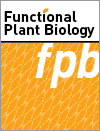The quality and yields of Sorghum bicolor plants are seriously affected by saline-alkali conditions. NAC (NAM, ATAF, and CUC) transcription factors are plant specific and have various functions in plant development and response to various stresses. It was found that GsNAC2-overexpressing plants showed higher saline-alkali tolerance in our study. These suggest that GsNAC2 acts as a potentially important regulator in response to saline-alkali stress and may be used in molecular breeding to improve crop yields under adverse environmental conditions.

Functional Plant Biology
Volume 50 Number 9 2023
FP22280Wounding induces suberin deposition, relevant gene expressions and changes of endogenous phytohormones in Chinese yam (Dioscorea opposita) tubers
 , Ping Geng, Xueyuan Jin, Xiaopeng Wei
, Ping Geng, Xueyuan Jin, Xiaopeng Wei  , Jing Xue, Xiaobo Wei
, Jing Xue, Xiaobo Wei  , Lihua Zhang, Mengpei Liu, Liang Zhang, Wei Zong and Linchun Mao
, Lihua Zhang, Mengpei Liu, Liang Zhang, Wei Zong and Linchun Mao 
Wounds on Chinese yam (Dioscorea opposita) tubers can ocurr during harvesting and handling, and rapid suberisation is required to prevent infection and desiccation. However, little is known about the causal relationship among suberin deposition, relevant gene expressions and endogenous phytohormones levels in response to wounding. Wound-induced abscisic acid and jasmonic acid are likely to regulate the biosynthesis, transport and polymerisation of suberin monomers by activating relevant gene expressions, which might be involved in suberisation of cells in wound area.
This study used liquid chromatography-mass spectrometry (LC-MS) to study the changes of small molecule metabolites of Suaeda salsa under salt and drought stress. We showed the main metabolites and metabolic pathways that changed under salt and drought stress environments, and revealed the molecular responses of S. salsa in response to salt and drought from the level of metabolomics.
This study evaluated the effects of ethylene pretreatment on the photosynthetic performance and tolerance of Zanthoxylum armatum seedlings to post-waterlogging reoxygenation stress. The results showed that reoxygenation stress decreased photosynthetic pigments content and enzymes activity, gas exchange parameters and chlorophyll fluorescence. However, ethylene pretreatment increased above indicators to enhance the tolerance to reoxygenation stress. These findings suggest that ethylene could be used to mitigate the impact of continued climate change on plant growth and development.
Excessive zinc reduces the photosynthetic levels of plants. In this study, we investigated how damage caused by Zn stress may be alleviated. We found that exogenous sulfate could improve the photosynthetic levels of the ornamental plant Hydrocotyle vulgaris under Zn stressed. The results of this study provide a reference for the restoration of Zn-contaminated environments by the combining of H. vulgaris with sulfate at the photophysiological level.
Nanotechnology offers enormous potential in agriculture, including alleviating the effects of climate change and enhancing abiotic stress management. Salicylic acid-functionalised chitosan nanoparticles (SA-NCS) were synthesised and their applications illustrated slow release of SA from SA-NCS, which may effectively protect developing anthers against heat stress in cotton. The study provides new insights into SA-NCS to improve source-sink imbalance and enlighten to restore sucrose metabolism for better growth of reproductive structure under heat stress in cotton (Gossypium hirsutum L.).



